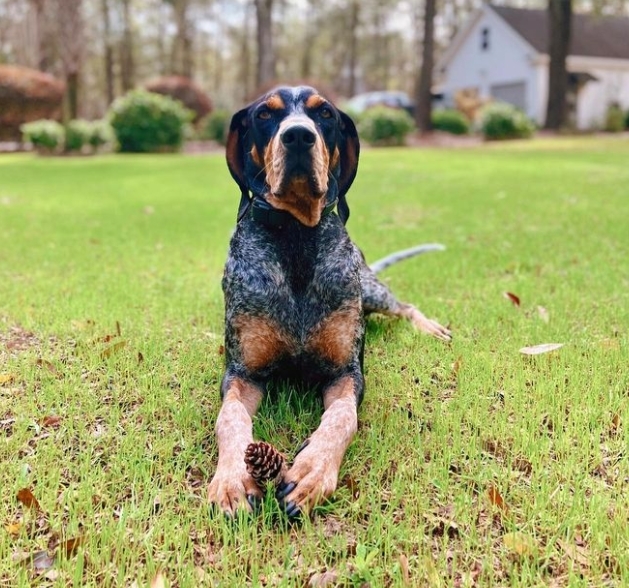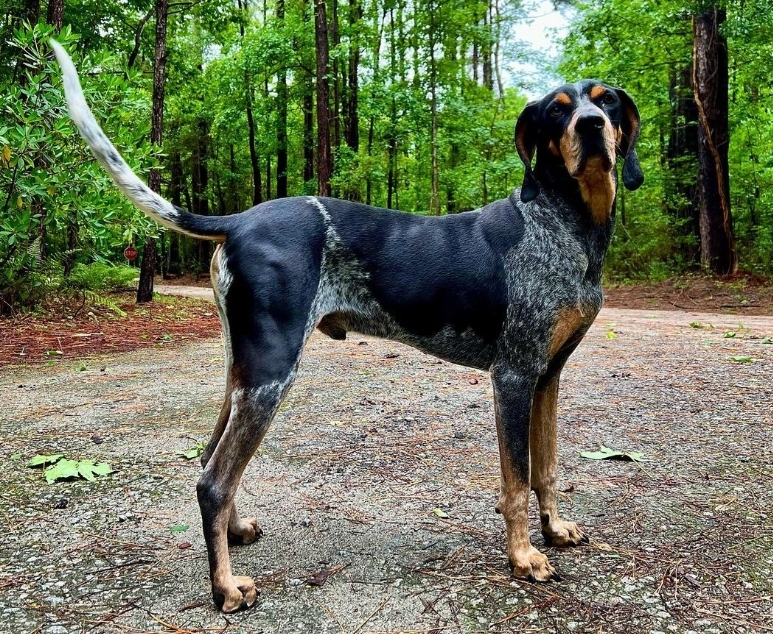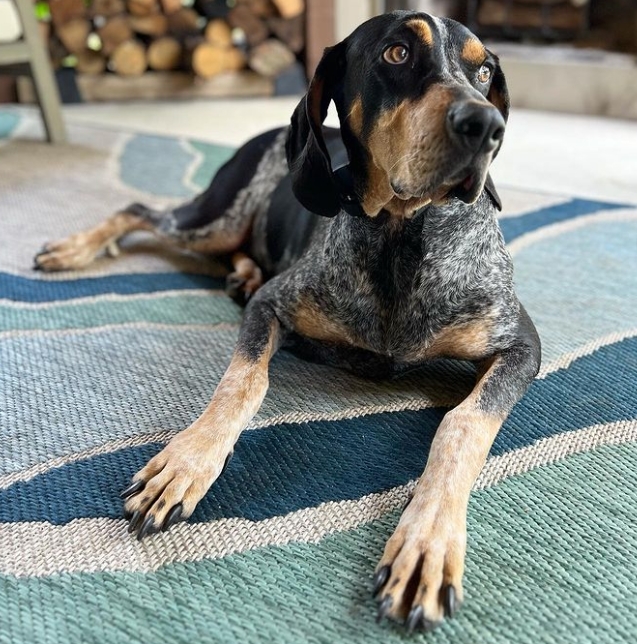Bluetick Coonhound
Table of Contents
When I think of hound dogs, I can't help but conjure up images of those endearing floppy ears, soulful eyes, and that unmistakable howl that tugs at your heartstrings. And among the various iconic hound breeds, there's one that has always stood out for me: the Bluetick Coonhound.
Its striking coat pattern and remarkable hunting abilities have always fascinated me. This breed holds a special place in American culture and history, and I've always admired its spirited nature.
Understanding the Bluetick Coonhound
The Bluetick Coonhound is a distinguished breed with a rich history that speaks volumes about its characteristics. Born from the intense need to have dogs with an exceptional sense of smell and unparalleled hunting capabilities, these hounds were meticulously bred to be experts in tracking and hunting.
Their distinct coat, marked with a mottled blue-black pattern, not only makes them stand out aesthetically but also serves as a testament to their unique genetic lineage.
But the Bluetick Coonhound isn’t just a hunting machine. Over time, as hunting became less of a necessity and more of a sport or pastime, these hounds transitioned into family life, proving that their versatility goes beyond the hunting grounds.
Today, they grace the homes of many, acting as loyal companions, playful buddies, and vigilant protectors. Their gentle demeanor, combined with a keen instinct, makes them both approachable for families and formidable against potential threats.

History and Origin
The Bluetick Coonhound, with its distinct appearance and renowned capabilities, has deep historical roots anchored in the southeastern United States. This breed is a product of meticulous breeding efforts that brought together the strengths of the English Foxhound and several French hounds, which were introduced to America during the colonial period.
The primary objective behind the breeding of Bluetick Coonhounds was to capitalize on their unmatched hunting prowess, especially in tracking and treeing raccoons. The southeastern terrain, with its dense forests and expansive wilderness, demanded a breed that could navigate the challenges of the environment and deliver exceptional results. The Bluetick Coonhound, with its keen sense of smell and steadfast determination, became an essential companion for hunters in the region.
An interesting aspect of this breed's identity is its name. The term “bluetick” is not just a fanciful descriptor; it refers to the dog's mottled blue-grey coat. This unique coat pattern not only adds to their visual appeal but also serves a functional purpose. During nocturnal hunting expeditions, their speckled coat acted as a form of camouflage, enabling them to blend seamlessly into the shadows and darkness of the southern nights.
Physical Characteristics
Size
The Bluetick Coonhound is recognized as a medium to large-sized breed. Adult males and females typically stand between 21 to 27 inches at the shoulder. Their weight can vary significantly, with individuals ranging from 45 to 80 pounds, depending on their gender, age, and overall health. This robust build, coupled with their notable height, offers them the endurance and strength essential for prolonged hunting expeditions.
Coat:
The coat of the Bluetick Coonhound is one of its defining features. It is short and glossy, requiring minimal grooming, making it practical for both fieldwork and family living. The coat is predominantly marked with a distinctive mottled blue pattern, which is enriched with various ticks and patches of different colors, mostly black and white. This unique patterning not only enhances their aesthetic appeal but also serves a utilitarian purpose, aiding in camouflage during hunting.
Appearance:
The Bluetick Coonhound exhibits a muscular and athletic build, a tangible reminder of its hunting lineage. The breed possesses a deep and well-sprung chest, allowing for greater lung capacity and endurance. The strong and slightly arched neck supports a head that is marked by a squarely-set jaw, indicating their biting strength. Their eyes are usually dark brown and radiate a keen and probing expression, reflective of their intense focus and intelligence.
Other Characteristics:
Beyond these primary features, the Bluetick Coonhound also has long, thin ears that frame their face and sharp, compact paws that provide them with the stability and agility needed to traverse diverse terrains. Their tail is also noteworthy; it is carried high and is often used for signaling during hunts.

Temperament and Personality
Bluetick Coonhounds are distinguished by their vibrant and tenacious temperament, making them a fascinating breed to consider. These dogs possess a unique blend of characteristics that set them apart.
- Intelligence and Alertness: Bluetick Coonhounds are renowned for their high intelligence and remarkable alertness. They exhibit a keen sense of awareness in their surroundings, making them excellent for tasks that require vigilance and quick thinking. Their intelligence also contributes to their adaptability and ability to learn new commands and tasks.
- Exceptional Scent Abilities: One of the most remarkable features of Bluetick Coonhounds is their extraordinary olfactory capabilities. They are often described as having a “nose that doesn't quit.” This extraordinary sense of smell makes them superb trackers, ideal for hunting and search-and-rescue operations.
- Family-Oriented: Despite their hunting lineage, Bluetick Coonhounds are known for their gentle and loyal nature towards their families. They form strong bonds with their human companions, making them great additions to households. Their loyalty and protective instincts ensure they are devoted and reliable pets.
- Interaction with Other Animals: Bluetick Coonhounds have a well-developed prey drive, which can make them less suitable for homes with small pets, such as rabbits or rodents. However, with proper socialization and training from an early age, they can coexist harmoniously with other animals. Socialization helps mitigate their hunting instincts and ensures they are comfortable around other pets.
- High Energy Levels: Bluetick Coonhounds are high-energy dogs. Their vivacious nature means they require regular exercise and mental stimulation to keep them satisfied and maintain their overall health. Long walks, runs, and engaging playtime are essential to meet their energy needs. Without adequate exercise, they may become restless or exhibit undesirable behaviors.
Training and Socialization
Training and socialization play a pivotal role in nurturing well-behaved and well-adjusted Bluetick Coonhounds. These dogs, with their independent disposition and strong hunting instincts, require a strategic and comprehensive approach to training:
Consistency is Key
Bluetick Coonhounds thrive on consistency in training methods. Utilizing reward-based training techniques, such as positive reinforcement, is highly effective. Consistent and clear communication between you and your Bluetick Coonhound will help them understand expectations and respond positively to commands.
Early Socialization is Crucial
Early socialization is paramount for Bluetick Coonhounds. Exposing them to a variety of environments, people, and other animals from a young age is essential. This exposure helps them develop into well-rounded and confident dogs. It also aids in mitigating their natural instinct to chase or hunt small animals, making them more adaptable in diverse social settings.
Exercise that Mimics Hunting Instincts
Bluetick Coonhounds have an innate drive for hunting and tracking scents. To satisfy this need, it's beneficial to incorporate activities that mimic their hunting instincts. Scent-tracking games, in particular, can provide both mental stimulation and physical exercise. Engaging in these activities not only fulfills their natural inclinations but also keeps them physically and mentally fit.
Ongoing Training
The training process for Bluetick Coonhounds should be ongoing. Regular practice and reinforcement of commands help maintain their responsiveness and ensure they continue to obey instructions as they grow older. Consistency in training sessions and integrating training into daily routines can yield the best results.
Patience and Positive Reinforcement
Patience is a virtue when training Bluetick Coonhounds. They may display independent tendencies, but with patience and positive reinforcement, you can build a strong and cooperative bond with them. Praising and rewarding good behavior is a powerful motivator for this breed.

Health and Lifespan
Bluetick Coonhounds are robust dogs with a typical life expectancy ranging from 11 to 12 years. While they are generally hardy, it's important to be aware of certain health predispositions that can affect them:
Common Health Issues
Bluetick Coonhounds, like many breeds, can be prone to specific health concerns. These include:
- Hip Dysplasia: This genetic condition involves abnormal development of the hip joint and can result in mobility issues and discomfort. Regular monitoring and early intervention can help manage this condition.
- Ear Infections: Bluetick Coonhounds' distinctive floppy ears can trap moisture and debris, making them susceptible to ear infections. Regular ear cleaning and care are essential to prevent these issues.
- Bloat: Bloat, or gastric torsion, is a potentially life-threatening condition where the stomach twists, causing a blockage of blood flow and gas buildup. This condition requires immediate veterinary attention.
Preventative Care
To ensure the well-being and longevity of your Bluetick Coonhound, it's crucial to implement preventative care measures:
- Regular Veterinary Check-ups: Routine visits to the veterinarian are essential. Regular check-ups can help detect and address health issues early, providing a higher chance of successful treatment.
- Balanced Diet: Providing a well-balanced and nutritionally appropriate diet is vital. Consult with your veterinarian to determine the best diet plan for your Bluetick Coonhound based on their age, activity level, and specific health needs.
- Maintaining a Healthy Weight: Obesity can exacerbate health issues in dogs. Ensuring your Bluetick Coonhound maintains a healthy weight through a combination of proper diet and regular exercise is essential.
- Ear Care: As mentioned earlier, paying attention to ear care is crucial. Clean your dog's ears regularly, and if you notice any signs of infection (e.g., redness, odor, excessive scratching), seek prompt veterinary care.
- Exercise and Mental Stimulation: Providing your Bluetick Coonhound with adequate exercise and mental stimulation not only keeps them physically fit but also mentally engaged and content.
Care and Maintenance
Ensuring the well-being and longevity of your Bluetick Coonhound requires thoughtful care and maintenance in various aspects of their daily life:
Dietary Considerations
To meet the unique needs of Bluetick Coonhounds, it's crucial to provide a balanced diet that is tailored to their size, age, and energy levels. Consult with your veterinarian to determine the most appropriate diet, whether it be commercial dog food or a home-cooked meal plan. Additionally, monitor their weight and adjust their portions as necessary to maintain a healthy body condition.
Grooming Routine
Bluetick Coonhounds sports a short coat that is relatively low-maintenance. However, regular grooming is still essential. Weekly brushing helps remove loose hair and keeps their coat clean and healthy. Periodic baths should be given when they get dirty or emit a distinct “hound odor.” Pay special attention to their ears, as hounds are prone to ear infections; clean them regularly and check for any signs of irritation.
Exercise Regimen
Bluetick Coonhounds are high-energy dogs, and they require daily exercise to remain physically and mentally stimulated. Incorporate daily walks, vigorous play sessions, or engaging activities that tap into their natural instincts, such as scent-tracking games. Providing ample exercise not only ensures their physical fitness but also helps prevent behavioral issues that may arise from pent-up energy.
Mental Stimulation
In addition to physical exercise, mental stimulation is crucial for Bluetick Coonhounds. These intelligent dogs thrive on challenges and problem-solving activities. Puzzle toys, interactive games, and obedience training can keep their minds sharp and prevent boredom.
Regular Veterinary Check-Ups
Routine veterinary check-ups are essential for monitoring your Bluetick Coonhound's overall health. Vaccinations, dental care, and preventive measures against parasites should be part of their healthcare regimen. Early detection of health issues is vital to ensure prompt treatment.
Social Interaction
Bluetick Coonhounds are social animals and thrive on interaction with their human family members. Spend quality time with them, offer affection, and engage in activities that strengthen your bond.

Bluetick Coonhounds in Popular Culture
Bluetick Coonhounds have made an indelible mark on popular culture, thanks to their distinctive appearance and hauntingly soulful howl. Their influence can be observed in various forms, from state recognition to appearances in songs and literature, demonstrating their enduring impact.
- State Dog of Tennessee: Bluetick Coonhounds hold a special place in the hearts of Tennesseans, as they have been designated as the official state dog of Tennessee. This honor reflects their historical significance and their deep connection to the state's cultural heritage, particularly in the realm of hunting and outdoor activities.
- Musical Tributes: Bluetick Coonhounds have been celebrated in the world of music through various songs and lyrics. Their distinctive howl often finds its way into country and folk tunes, contributing to the rich musical tapestry of rural America. These songs not only capture the essence of the breed but also convey the sentiments of those who cherish them.
- Literary References: Bluetick Coonhounds have also found their way into the pages of literature. Authors and storytellers have woven their unique traits and characteristics into narratives, showcasing their hunting prowess, loyalty, and endearing personalities. These literary references serve to immortalize the breed's role in the human experience.
- Film and Television Appearances: Beyond print and music, Bluetick Coonhounds have graced the silver screen and television screens. They have made appearances in movies and TV shows, often portraying loyal and courageous canine companions. These on-screen depictions further cement their status as iconic and beloved dogs in the world of entertainment.
- Social Media and Online Communities: In the digital age, Bluetick Coonhounds continue to garner attention through social media platforms and online communities. Enthusiasts and owners share their love for the breed, posting photos, stories, and anecdotes that celebrate the unique attributes of Bluetick Coonhounds. These online communities serve as hubs for connecting with fellow admirers and exchanging valuable information about the breed.
Frequently Asked Questions (FAQs) About Bluetick Coonhounds
1. What is a Bluetick Coonhound?
A Bluetick Coonhound is a distinctive breed of hound dog known for its mottled blue-black coat pattern, exceptional hunting capabilities, and loyal, family-friendly nature. They were originally bred for hunting raccoons but have transitioned into family life.
2. What is the history and origin of Bluetick Coonhounds?
Bluetick Coonhounds have deep historical roots in the southeastern United States. They were developed by breeding English Foxhounds and various French hounds during the colonial period to create expert hunters capable of tracking and treeing raccoons.
3. What are the physical characteristics of Bluetick Coonhounds?
Bluetick Coonhounds are medium to large-sized dogs with a muscular and athletic build. They have short, glossy coats with a distinctive mottled blue pattern, long ears, and sharp, compact paws. Their eyes are usually dark brown, and their tail is carried high.
4. What is the temperament and personality of Bluetick Coonhounds?
Bluetick Coonhounds are known for their intelligence, alertness, and exceptional scent abilities. They are family-oriented, loyal, and protective. However, they have a strong prey drive, which can be managed through proper socialization and training.
5. How should Bluetick Coonhounds be trained and socialized?
Training should be consistent and utilize positive reinforcement methods. Early socialization is crucial to expose them to various environments, people, and other animals. Activities that mimic their hunting instincts, such as scent-tracking games, are beneficial for their mental and physical well-being.
6. What are the common health issues in Bluetick Coonhounds?
Common health concerns include hip dysplasia, ear infections due to their floppy ears, and bloat (gastric torsion). Regular veterinary check-ups, a balanced diet, and maintaining a healthy weight can help prevent and manage these issues.
7. How should Bluetick Coonhounds be cared for and maintained?
Care involves providing a balanced diet, regular grooming, ample exercise, mental stimulation, and routine veterinary check-ups. Attention to ear care, as well as social interaction and quality time with their human family, is important for their well-being.
8. Are Bluetick Coonhounds famous in popular culture?
Yes, Bluetick Coonhounds have left their mark on popular culture. They are the official state dog of Tennessee, have been celebrated in music, literature, and film, and have a strong presence in social media and online communities.
9. Are Bluetick Coonhounds suitable as family pets?
Yes, Bluetick Coonhounds can make excellent family pets. They are known for their loyalty and gentleness with their human companions. However, their high energy levels require active families who can provide them with the necessary exercise and mental stimulation.
10. Do Bluetick Coonhounds get along with other pets?
Bluetick Coonhounds may have a strong prey drive, so early socialization is essential to help them coexist harmoniously with other pets. With proper training and exposure, they can get along with other animals, but caution should be exercised with small pets like rabbits or rodents.
Conclusion
In conclusion, the Bluetick Coonhound is a breed that has captured my heart with its distinctive charm, rich history, and unique attributes. As I delved into understanding these spirited canines, I couldn't help but admire their striking appearance and remarkable hunting prowess.
Their journey from dedicated hunters to beloved family members showcases their adaptability and versatility. Through the lens of their history, physical characteristics, temperament, and care requirements, I've come to appreciate the depth of their connection to American culture and the special place they hold in the hearts of enthusiasts.
Whether celebrated in songs, literature, or on the screen, Bluetick Coonhounds have left an indelible mark on popular culture. It's clear that these dogs, with their loyal and intelligent nature, continue to be cherished companions, embodying the enduring spirit of the American hound.
Sources
https://dogtime.com/dog-breeds/bluetick-coonhound
https://vgl.ucdavis.edu/breed/bluetick-coonhound
Bluetick Coonhound Photos



